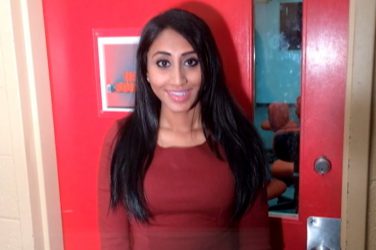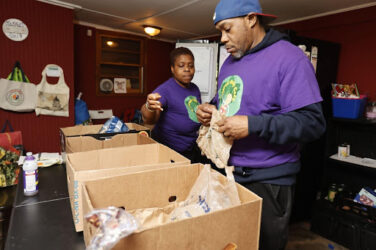By Macey Lauren
According to the American Cancer Society, 1 in 8 American women will discover that she has breast cancer during her lifetime.
After hearing that she had the most common form of breast cancer, Invasive Ductal Carcinoma at only 39 years old, Stephanie Sharp pointedly asked her doctor, “Are you gonna cut off my boobs?”
Today more women are electing to have a mastectomy procedure to fully remove their breast in order to treat the cancer. The American Cancer Society estimates that anywhere from 20% to 40% of women who chose to surgically remove their breasts also have some form of reconstruction. For many women undergoing this process, the last step after leaving the operating room is a stop at a tattoo parlor.
Healing with Ink
 Ron Hendon’s chair at Midnight Iguana Tattoo in Athens, Georgia is no stranger to seating breast cancer survivors. Using the same machine and ink he’d use to tattoo a skull, dragon, or swallow design, Ron is able to create a realistic-looking nipple on women who have lost theirs as a result of their mastectomies.
Ron Hendon’s chair at Midnight Iguana Tattoo in Athens, Georgia is no stranger to seating breast cancer survivors. Using the same machine and ink he’d use to tattoo a skull, dragon, or swallow design, Ron is able to create a realistic-looking nipple on women who have lost theirs as a result of their mastectomies.
The medical term for the procedure is called Micro-pigment Implantation, which means recoloring skin with flesh tone-colored ink to replace lost pigment. Hendon says it is essentially a tattoo made to look like a natural areola and nipple. Traditionally, the same plastic surgeon that performed the breast reconstruction would then pick up a tattoo machine and add color to the areolas he or she had just created. This practice is changing now, as more and more breast cancer survivors are heading into tattoo shops for a more lifelike design that only a skilled artist can achieve.
“For me it’s a pretty simple tattoo. I just have to match the areola color and use a little shading techniques, and then you’ve got a nipple that can look even better than it did naturally, ” says Hendon. He has been doing these tattoos for over 20 years now and it has become a passion of his.
Mastectomy tattoos are gaining popularity among breast cancer survivors. Not only do these tattoos look incredibly realistic and almost three-dimensional, they also offer breast cancer survivors a sense of comfort in reclaiming something they had to sacrifice to the disease.
“People don’t realize how important having a nipple is to feeling feminine and like a woman,” Sharp continues, “And most women don’t know what kind of options there are for reconstruction until they have to know—when they are diagnosed.”
 Following her breast cancer diagnosis in early 2011, Sharp kept a blog chronicling her almost year-long journey through cancer treatments, including eight rounds of chemotherapy, radiation, and reconstruction. In her last post she talks about finally getting this tattoo done as the final step of her reconstruction process, almost three and a half years after her
Following her breast cancer diagnosis in early 2011, Sharp kept a blog chronicling her almost year-long journey through cancer treatments, including eight rounds of chemotherapy, radiation, and reconstruction. In her last post she talks about finally getting this tattoo done as the final step of her reconstruction process, almost three and a half years after her
mastectomy.
Sharp says her decision to get the tattoos was an easy one to make, “For me it was a little over an hour of my time, 400-dollars, and I came out feeling like a complete woman again.”
Not Only Nipples
Mastectomy tattoos are not always just tattoos of nipples. Some women chose to have a more artistic design to cover the battle scars breast cancer has left them with. Hendon says he has seen this trend start primarily in California, and he has been asked to do more and more designs in the past few years. The most requested designs coming out of his shop are any type of flower. Hearts and pink ribbons to symbolize breast cancer awareness are other popular choices he has seen used to mask scars.
 While a majority of the clients Hendon has coming in for this type of tattoo are breast cancer survivors, it is not an exclusive procedure to those who have battled the disease. Roxie Greene has never had breast cancer, but she did have a breast reduction that left her with several scars across her chest that resembled that of a mastectomy.
While a majority of the clients Hendon has coming in for this type of tattoo are breast cancer survivors, it is not an exclusive procedure to those who have battled the disease. Roxie Greene has never had breast cancer, but she did have a breast reduction that left her with several scars across her chest that resembled that of a mastectomy.
“I would look in the mirror and just cry, it was horrible to look at,” Greene explains, “I wanted to cover them with something pretty, like art.”
Hendon tattooed vines of purple and pink flowers across Greene’s chest over all of her scars from surgery. Greene says that she sees her tattoos as a work of art that has completely elevated her self-confidence.
She says, “My tattoos have changed my life so much, and for any woman who has had breast cancer, it must really be something for her. There is so much that can be done, and you can choose whatever you want to make it beautiful.”
“The easiest tattoo you’ll ever get”
Both women agree that these tattoos have helped them reclaim their femininity and feel truly beautiful. And for those who have fought through the disease and come out on top, these tattoos are nothing in comparison to what they have previously faced.
Sharp wants other women who fear tattoo needles and the pain that comes with getting inked to know that the process is actually quite painless. During a mastectomy, nerves are severed as tissue is removed. As a result, Sharp lost all of the feeling where her breasts were operated on. When discussing how her experience getting tattooed was, she says, “It was the easiest tattoo you’ll ever get.”
From Under the Knife to Under the Needle
For those considering getting a mastectomy tattoo, Hendon stresses this is not the kind of tattoo you can just walk into any downtown parlor and request. He says it is important to find a reputable artist who knows how to properly work with the skin of reconstructed breasts.
P.Ink is a non-profit organization that aims to connect breast cancer survivors with tattoo artists. On both the website and mobile application, users who are interested in getting a tattoo fill out a short application. Then the organization connects each woman with a tattoo artist who specializes in mastectomy tattoos.
There are over 3 million breast cancer survivors in the United States alone, but even after the cancer is gone, its effects last far beyond the removal of the invasive cells. Mastectomy tattoos offer women a chance to disguise their scars under something beautiful or simply regain part of what has been lost in the fight.
“The people that I get to tattoo aren’t just leaving with a tattoo. They can finally feel okay again and be comfortable with their bodies. It’s a new normal, or better than normal, that I’m glad to be a part of,” says Hendon.







